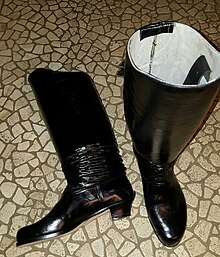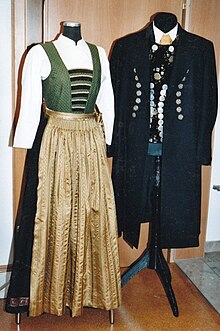Hallertau costume
The Hallertau costume is a folk costume that is worn in the Bavarian region of Hallertau and shares style elements with the Dachau and Ampertal folk costume . In professional circles, the similar folk costumes are also known as Unterländler or Old Bavarian costumes, which can be found from the Lech region to the eastern foothills of the Alps. In general, it has always been considered to be very expensive, regionally different, festive clothing strongly influenced by rural and urban areas, which should reflect the rank and status of the wearer.
history
Before 1800
The development of the Hallertau costume is in the dark. Only the Bavarian, class dress code according to Elector Maximilian I , which has been in force since 1644 and which was implemented by the regional courts, is documented and is considered to be the origin of the development of regional, class and occupation-dependent national costumes.
1800
The Hallertau costume was first described by the regional directorate Joseph von Hazzi at the Moosburg regional court around 1808.
" For the man, the clothes consist of a black or blue skirt, red waistcoat, trousers by Zwilch - in summer mostly without stockings and shoes - the women are dressed in blue linen.
The Ampertal makes a striking difference. The male and female sex here are large and well formed; the man wears a fine blue skirt, red waistcoat, green suspenders over it and a belt (satchel), then black leather trousers, blue stockings and a shoe with ribbons.
The women have short but thickly padded black skirts, a black gauntlet, a stiff bodice and everything is pulled together at the neck, the head is covered by a large black cap from Otter. The younger girls have blue bonnets with tips and a kind of casquet underneath which their hair is plaited - each has a belt made of silver or metal around their bodies - at the dance you can see beautiful white stockings and fine white shawls with tips on the head. "
1860
In 1860 the costume was given to the district court doctor Dr. Karl Lauterbach described in detail as follows:
“In general, as everywhere in the country, the way people dress is an imitation of the fashions in the neighboring cities, which always comes some time later. ... The wealthy peasant of recent times ... wears a modern skirt with a long waist and laps to the knees, on which only the silver buttons distinguish the country dweller. The waistcoat is made of flowered atlas or velvet, also with silver buttons, which consist almost entirely of worn-in women in their twenties and twelve, sometimes in a more modern style. A silver watch chain is emblazoned above the vest. The almost shivering, very wide pants made of leather go down to the ankles; But over them he wears polished boots, the shafts of which reach up over the calves and often cause pressure to inhibit free blood circulation and varicose swellings. … For poorer men and boys, the black felt hat is wrapped with a double black silk cord and decorated with 2 thick black tassels or tassels; in the more affluent, these are heavily twisted with real gold thread. "
He reports on the clothing of the women: “The elite of the rural women,
landlords and millers, as well as the young heiress of a rich farm here and there… wear the so-called bourgeois costume. ... This costume, which is also common in the Mainburg and Au markets, consists of a skirt and lower dispenser made of the same material, made of Pers (cotton fabric), wool or silk, a sticking apron tied with silk ribbons, a bodice made of heavy black silk with black or golden embroidery, silver corset hooks, a heavy silver cord often 10-12 cubits long, hung with silver and gold-plated thalers ..., a heavy silk pocket square, knocked-out lace or chemisette around the neck, a multi-thread silver necklace with a nicely crafted lock, and finally a bolt hood of silver or gold. The head was otherwise covered by a so-called summer time. Ribbon bonnet, a small silk cup. In winter time, the farmer's wife used to wear a fur cap made of black rabbit fur ... with a gold-embroidered bottom, and this fur cap is now accepted for both young and old in all seasons, including in the hottest summer ... "
After 1880
By 1880, the Hallertau costume was almost extinct. Due to the public appearances of Prince Regent Luitpold , who had been in office since 1886 , the Miesbach mountain costume became fashionable and almost completely replaced the Hallertau costume.
The Hallertau costume could be preserved through a few private individuals, photo documents and the establishment of various traditional costume associations in the Hallertau.
Components of the boys and men costume
cap
The black felt hat with a wide brim is double-wound with a black silk cord and can also have one or two tassels that dangle over the brim. For wealthy wearers, the hat cord is twisted from gold thread. There are also hat versions made of rabbit fur.
skirt
On festive days and when going to church, master craftsmen, farmers or married men wear a skirt (also known as a gevatters skirt or roast skirt). Depending on the stand, it is made of black, brown, blue or green cloth and reaches below the knees. It is cut very tight and tailored to the waist. The lap is provided with a hook slot from the high waist and is studded with two pairs of silver buttons. The peculiarity of the lap is that it widens like a bell downwards and does not fall straight. In the inner lining under the hook slot there is a medium-sized pocket for storing your wallet or prayer book. The front is double-rowed with six to eight pairs of silver buttons, but is always worn open. The collar is made of the same material, but occasionally also with a velvet border.
Since around 1850, no coin buttons have been used on skirts, but rather "roserl", "star" or "wagon wheel" buttons made of silver.
Janker
The jacket is cut shorter than a jacket and usually ends at the waist. It is tailored from fine loden and has a turn-down collar and two side pockets. It is set with coin or silver buttons on both sides, but is worn open.
shirt
The white linen shirt with long sleeves has either a stand-up collar or a tight turn-down collar.
Tie
A small scarf, tie or a so-called Schmiessl is worn, but almost completely covered by the high-necked vest.
Gilet (vest)
The high-necked gilet is often made of floral velvet, cloth or atlas . The front is mostly studded with up to 20 silver buttons made from 10, 20 or 30 pieces of Bavarian cruiser . More recently, silver decorative buttons have also been used. It has two outside pockets and can sometimes have a turn-down collar. In terms of color, it is traditionally mostly red or black.
trousers
The black trousers were gradually replaced by very wide, ankle-length boot trousers made of leather, mostly deerskin. The trousers have either a fly or a bib.
Silk suspenders can also be worn with the trousers. But this is worn underneath the gilet.
belt
A wide belt with a large buckle, the so-called satchel, can also be worn as a status symbol for master craftsmen and farmers.
Boots
The particularly elaborately manufactured pleated boots that reach over the calves should, depending on the number of folds, give the viewer an expression of the wealth of the wearer. The heels are straight or curved, trimmed with leather and can be shod with horseshoes. The boot shaft is mostly not covered with decorative stitching.
Jewellery
A charivari or a long silver watch chain, wrapped around the neck and tied to the silver buttons, is worn as an additional status symbol . You should be able to hear these pieces of jewelry while walking.
Components of girls 'and women' s costume
The woman's festive or church gwanda was part of the dowry. The church wall of a Hallertau peasant woman corresponded to the equivalent of the annual salary of a maid.
Headgear
The ladies wear beehive-shaped otter or rabbit fur hats, a headscarf tied to the back or a bolt cap , which should be silver, gold or black depending on their marital status . With fur hats and headscarves, the hairline above the forehead must not be visible.
garment
Skirts and aprons are mostly made of different patterns and colors of silk and are ankle-length. The gold-embroidered bodice was replaced by the "Munich bodice" from around 1850. The way in which the knot is tied on the apron provides information about the marital status of the woman. A key on the node shows that she is the owner of the house. The woman wears a fringed shawl around her shoulder that is pinned to the back with a brooch.
The clothing is complemented by a dispenser, a small jacket made of the same or color-matching material to the dress.
Shoes
Women mostly wear fine buckled shoes made of black leather with silver clasps and a slight heel.
Jewellery
The women wear a silver corset lace richly decorated with coins, amulets and medals and a corset stud decorated with pearls or stones.
Hop dirndl
In 1952, the hops dirndl was presented at the Bavarian Central Agriculture Festival in Munich . It was designed as a hops costume for rural youth and was later sewn in agricultural schools.
It consists of a green top with round velvet and gold braids, a brown skirt and a gold-colored apron. The colors stand for the green of the hops , the brown of the earth and the gold for the lupulin of the cones.
literature
- Joseph von Hazzi : Statistical information about the Duchy of Baiern obtained from genuine sources; a general contribution to the country u. Human studies. Nuremberg 1808.
- Felix Friedrich von Lipowsky : Representation of the social and economic folk life of the royal Bavarian regional court district Moosburg in the government district of Upper Bavaria. Munich 1861.
Individual evidence
- ↑ Hallertauer Hopfen- und Heimatmuseum Geisenfeld eV ( Memento of the original from June 4, 2009 in the Internet Archive ) Info: The archive link was inserted automatically and has not yet been checked. Please check the original and archive link according to the instructions and then remove this notice. : Archive 2004-1. Chairman father: Old Bavarian costume, accessed on December 30, 2015.
- ↑ Spielmannszug Siegenburg ( Memento of the original dated December 23, 2015 in the Internet Archive ) Info: The archive link was inserted automatically and has not yet been checked. Please check the original and archive link according to the instructions and then remove this notice. , accessed December 22, 2015.
- ↑ Joseph von Hazzi: Statistical information about the Duchy of Baiern obtained from genuine sources; a general contribution to the country u. Human studies. Nuremberg 1808.
- ^ Hallertauer Volkstrachtenverein Mainburg : The Mainburg costume. accessed on December 22, 2015.
- ^ GTV Isartaler Moosburg eV : History, accessed on December 22, 2015.
- ↑ Trachten-Raith ( Memento of the original from January 26, 2016 in the Internet Archive ) Info: The archive link was inserted automatically and has not yet been checked. Please check the original and archive link according to the instructions and then remove this notice. : The hop dirndl. accessed on December 22, 2015.





